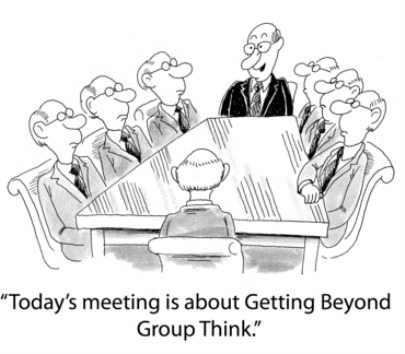What is a Safety and Risk ‘Thinking Group’?
 When we take time out to critically think through, and challenge, the ‘norm’ in risk and safety, we open up our eyes, and importantly our minds, to new thinking and innovation when we use our imagination to better discern risk
When we take time out to critically think through, and challenge, the ‘norm’ in risk and safety, we open up our eyes, and importantly our minds, to new thinking and innovation when we use our imagination to better discern risk
In my last post Some Basics on Social Psychology of Risk I wrote about some of the basics of social psychology as they apply to dealing with risk. In the article, I offered some ideas for how people sharing this new learning could go about putting it into practice, as well as create an environment to support our learning. One of the ideas that I suggested was to create, or become part of, a supportive community. A specific idea was to develop or become part of one of our ‘Thinking Groups’. I received some great responses to the article as well as lots of questions about details of the Groups.
We now have Groups set up in Newcastle, Central Coast and Sydney in NSW as well as Melbourne (Victoria) and since the last post we’ve set one up in Brisbane (Queensland). We’ve also had feedback and questions from people in other areas of Australia as well as the US, Europe, Nigeria, New Zealand and Singapore, all keen to understand exactly what a ‘Thinking Group’ is and how they work. So I thought I’d share some of our experiences and a few ideas and tips to help you establish your own Group.
Our Thinking Groups started when a few of us who are studying the post graduate Masters program in Social Psychology and Risk (see – Post Graduate Studies ) through the Australian Catholic University (ACU) were looking for different ways to support our thinking and the new learning we were sharing. We were all exploring so many new ideas and concepts, and as I mentioned in my last post, going through significant ‘unlearning’. We were looking for a forum beyond our formal studies to share our ideas in a safe environment. It’s great that the Groups have now expanded beyond our ‘study group’ to include people who are keen to learn and think more about people.
This idea and concept of the Groups is to ‘take time out’ to ‘think’ in a different way. We try to think critically and to challenge the ‘norm’ by exploring beyond the first layer or two of the metaphorical onion. We try to understand risk beyond objects, law and systems. We are all interested in learning more about people and how we make decisions and judgments. We use this as the focus of our thinking.
The simplest way to explain how our meetings run is to think of them as similar to a book club. In fact we often use a book, or at least a key question or thesis from a book, as the topic of discussion/thinking for a meeting.
Some examples of topics/questions that we have talked through in meetings to date include:
· Can a bully also be a good manager? – This initially created discussion that focussed on the definition of bully and manager. The really good thinking and discussion however began when someone asked the question: “So what is it about the social construct and environment that allows some mangers to bully others?”.
· Humble Enquiry – the Group read the great book by Edgar Shein and talked through how this is applied to those working in the risk and safety industry. We soon realised how difficult it can be to practice the art of the ‘humble enquiry’ and how foreign this is to some of us who work in the industry where we have grown up ‘telling’. I particularly enjoyed this discussion and the encouragement that the Group provided to each other to ‘ask instead of tell’.
Here are some other great topics that you might like to discuss/think about which are provided courtesy of Dr Robert Long who is the facilitator of our post graduate program:
· What is the ‘hero myth’ and how is this evident in modern management and leadership discourse?
· What is the ‘art’ followership?
· Can an effective leader be authoritarian?
· What is The Authoritarian Personality (TAP)? Why should managers know about TAP?
· Discuss the nature of power and the attraction of leadership.
· What part does altruism, giving and sharing play in successful leadership?
We try to explore topics beyond the standard and the ‘norm’, and try to understand some of the “Y” behind questions and challenges, not just the ‘stuff’ that sits on the surface which we believe has been done many times over. We are interested in deeper and more critical thinking, this is what we think is fun!
Our meetings are very informal (no agenda, minutes and that kind of stuff) and are usually in Cafe’s or similar over coffee.
I hope this provides further clarity around what our ‘Thinking Groups’ are about and also some ideas and suggestions for how can go about setting one up. If you’d like more details or want to chat in person, my contact details are below, and I’d welcome your contact and questions.
Author: Robert Sams
Phone: 0424 037 112
Email: robert@dolphyn.com.au
Facebook: Dolphin Safety Facebook Page



Do you have any thoughts? Please share them below